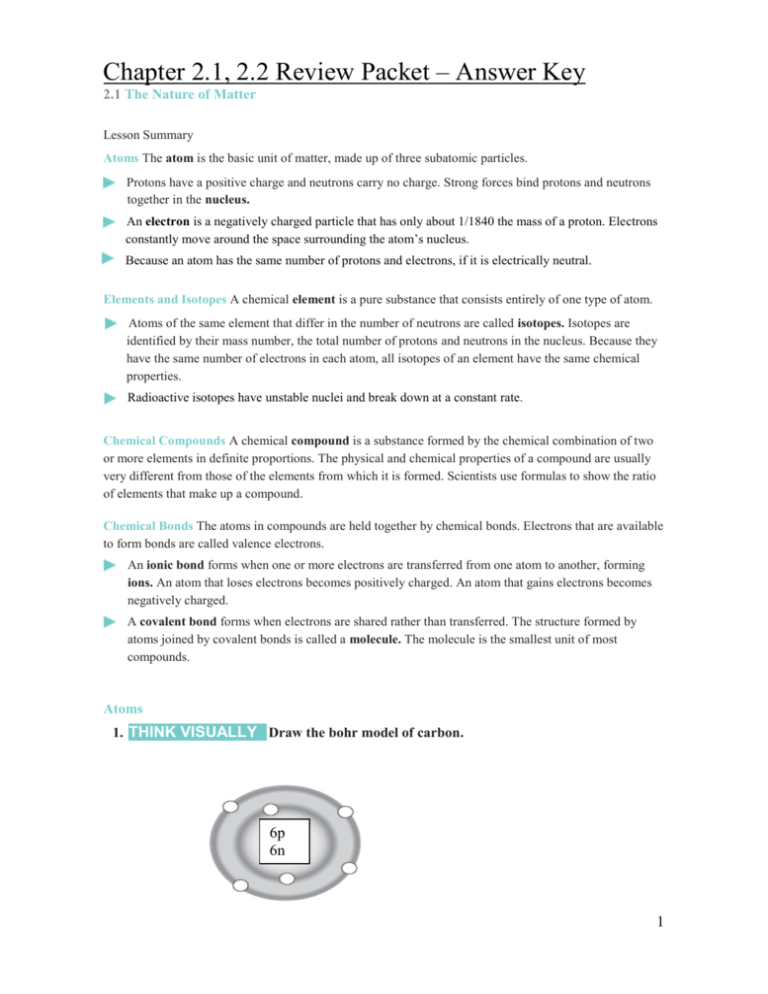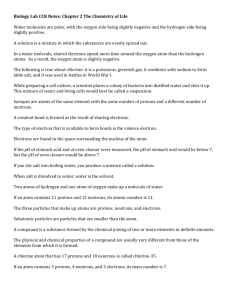Chapter 2.1, 2.2 Review Packet – Answer Key
advertisement

Chapter 2.1, 2.2 Review Packet – Answer Key 2.1 The Nature of Matter Lesson Summary Atoms The atom is the basic unit of matter, made up of three subatomic particles. Protons have a positive charge and neutrons carry no charge. Strong forces bind protons and neutrons together in the nucleus. An electron is a negatively charged particle that has only about 1/1840 the mass of a proton. Electrons constantly move around the space surrounding the atom’s nucleus. Because an atom has the same number of protons and electrons, if it is electrically neutral. Elements and Isotopes A chemical element is a pure substance that consists entirely of one type of atom. Atoms of the same element that differ in the number of neutrons are called isotopes. Isotopes are identified by their mass number, the total number of protons and neutrons in the nucleus. Because they have the same number of electrons in each atom, all isotopes of an element have the same chemical properties. Radioactive isotopes have unstable nuclei and break down at a constant rate. Chemical Compounds A chemical compound is a substance formed by the chemical combination of two or more elements in definite proportions. The physical and chemical properties of a compound are usually very different from those of the elements from which it is formed. Scientists use formulas to show the ratio of elements that make up a compound. Chemical Bonds The atoms in compounds are held together by chemical bonds. Electrons that are available to form bonds are called valence electrons. An ionic bond forms when one or more electrons are transferred from one atom to another, forming ions. An atom that loses electrons becomes positively charged. An atom that gains electrons becomes negatively charged. A covalent bond forms when electrons are shared rather than transferred. The structure formed by atoms joined by covalent bonds is called a molecule. The molecule is the smallest unit of most compounds. Atoms 1. THINK VISUALLY Draw the bohr model of carbon. 6p 6n 1 Elements and Isotopes 2. THINK VISUALLY The diagrams show models of carbon isotopes. Complete the diagrams by drawing in the rest of the atomic particles, remember that the number at the end represents that isotopes specific mass. 6p 8n 6p 7n Nonradioactive carbon-13 Radioactive carbon-14 Use your completed diagrams to answer Questions 3–4. 3. Identify two differences between carbon-12 and carbon-14. Mass is different (12 amu vs. 14 amu) Neutron count is different (7 vs. 8) 4. Identify two ways in which carbon-12, carbon-13, and carbon-14 are alike. All have the same proton count (6 protons) All have the same electron count (6 protons) For Questions 5–7, complete each statement by writing the correct word or words. Choice of words: ions, isotopes, atoms, electrons 5. A chemical element is a pure substance that consists entirely of one type of atoms. 6. Atoms of the same element that differ in the number of neutrons they contain are called isotopes. 7. An atom is made up of protons, neutrons, and electrons. Chemical Bonds 10. Sea salt contains calcium chloride (CaCl2), an ionic compound similar to table salt. One atom of calcium (atomic number 20) bonds to two atoms of chlorine (atomic number 17). Fill in the number of protons and electrons in each ion. Chloride ion Calcium ion Chloride ion Protons 17 Protons 20 Protons 17 Electrons 18 Electrons 18 Electrons 18 2 Chemical Symbol Chemical Name Atomic number Protons Neutrons Electrons Atomic mass B Boron 5 5 6 5 11 Na Sodium 11 11 13 11 24 Ga Gallium 31 31 37 31 68 Y Yttrium 39 39 50 39 89 Cu Copper 29 29 35 29 64 Tc Technetium 43 43 57 43 100 Pb Lead 82 82 125 82 207 Yb Ytterbium 70 70 102 70 172 Ac Actinium 89 89 136 89 225 Mo Molybdenum 42 42 53 42 95 Tl Thallium 81 81 125 81 206 Fm Fermium 100 100 159 100 259 No Nobelium 102 102 159 102 261 Yb Ytterbium 70 70 102 70 172 Sg Seaborgium 106 106 159 106 265 2.2 Properties of Water The Water Molecule Water molecules (H2O) are polar because of an uneven distribution of electrons, creating a slight negative (–) charge in the oxygen atom and a slight positive (+) charge in each hydrogen atom. The attraction between a hydrogen atom of one water molecule and the oxygen atom of another water molecule is called a hydrogen bond. Cohesion is an attraction between molecules of the same substance. It causes water molecules to be drawn together, producing surface tension Adhesion is an attraction between molecules of different substances. It causes capillary action, an effect that causes water to rise in a narrow tube against the force of gravity. Solutions and Suspensions A mixture is a material composed of two or more elements or compounds that are physically mixed together but not chemically combined. A solution is a mixture in which all the components are evenly spread out: the substance dissolved is the solute; the substance that causes the dissolving is the solvent. Mixtures of water and undissolved materials are suspensions. Acids, Bases, and pH A water molecule (H2O) can split apart to form a hydrogen ion (H+) and a hydroxide ion (OH–). The pH scale measures the concentration of hydrogen ions in a solution. The scale ranges from 0 to 14. Pure water has a pH of 7. An acid is any compound that forms H + ions in solution. Acidic solutions have pH values below 7. A base is a compound that forms OH– ions in solution. Basic, or alkaline, solutions have pH values above 7. Buffers are weak acids or bases that can react with strong acids or bases to prevent sudden changes in pH. 3 The Water Molecule For Questions 1–4, write True or False on the line provided. True 1. Water is a polar molecule. False 2. Hydrogen bonds are an example of adhesion. False 4. A hydrogen bond is stronger than a covalent bond. Solutions and Suspensions 5. Complete the table Substance Definition Example(s) Physical combination of two or more substances Cinnamon sugar Solute What is being dissolved Salt in saltwater Solvent What is doing the dissolving water Suspension Mixture of water and nondissolved substance Blood Solution A homogeneous mixture where the solvent is mixed uniformly throughout. Mixture Acids, Bases, and pH 6. What makes pure water neutral? Pure water is neutral due to its lack of ions and other dissolved particles. Also it has a pH of 7. 7. What does the pH scale measure? The amount of H+ ions present. The more acidic it is the more H+ ions it has. 8. On the pH scale, indicate which direction is increasingly acidic and which is increasingly basic Going towards the strong acid is increasingly acidic, and going towards the strong base is increasingly basic. 9. Identify two solutions that have more H+ ions than OH– ions. Anything acid has more H+ than OH-. Example: lemon juice and HCl 10. Identify two solutions that have more OH– ions than H+ ions. Anything basic. Example: NaOH and ammonia 11. How would you buffer a solution that has a pH of 12? Mix it with a solution that is equally acidic (pH of 2) Apply the Big idea 12. Why are buffers important to living things? Buffers are important because they help to keep our pH levels in balance. For example the water in our bodies helps to balance out the acid and bases that we ingest and create. 4








